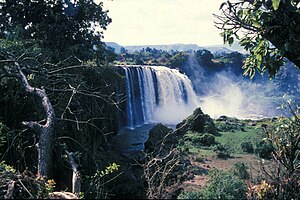Blue Nile Falls: Difference between revisions
No edit summary |
Rescuing 1 sources and tagging 0 as dead. #IABot (v1.2.6) |
||
| Line 4: | Line 4: | ||
The '''Blue Nile Falls''' is a [[waterfall]] on the [[Blue Nile]] river in [[Ethiopia]]. It is known as '''Tis Abay''' in [[Amharic]], meaning "great smoke". It is situated on the upper course of the river, about 30 km downstream from the town of [[Bahir Dar]] and [[Lake Tana]]. The falls are considered one of Ethiopia's best known tourist attractions. |
The '''Blue Nile Falls''' is a [[waterfall]] on the [[Blue Nile]] river in [[Ethiopia]]. It is known as '''Tis Abay''' in [[Amharic]], meaning "great smoke". It is situated on the upper course of the river, about 30 km downstream from the town of [[Bahir Dar]] and [[Lake Tana]]. The falls are considered one of Ethiopia's best known tourist attractions. |
||
The falls are estimated to be between 37 and 45 metres high, consisting of four streams that originally varied from a trickle in the dry season to over 400 metres wide in the rainy season. Regulation of Lake Tana now reduces the variation somewhat, and since 2003 a hydro-electric station has taken much of the flow out of the falls except during the rainy season.<ref>Matt Philips and Jean-Bernard Carillet, ''Ethiopia and Eritrea'', third edition (n.p.: Lonely Planet, 2006), p. 118</ref> The Blue Nile Falls isolate the ecology of Lake Tana from the ecology of the rest of the Nile, and this isolation has played a role in the evolution of the endemic fauna of the lake.<ref>[http://www.feow.org/ecoregion_details.php?eco=526 "526: Lake Tana"], Freshwater ecosystems of the world website (accessed 11 November 2009)</ref> |
The falls are estimated to be between 37 and 45 metres high, consisting of four streams that originally varied from a trickle in the dry season to over 400 metres wide in the rainy season. Regulation of Lake Tana now reduces the variation somewhat, and since 2003 a hydro-electric station has taken much of the flow out of the falls except during the rainy season.<ref>Matt Philips and Jean-Bernard Carillet, ''Ethiopia and Eritrea'', third edition (n.p.: Lonely Planet, 2006), p. 118</ref> The Blue Nile Falls isolate the ecology of Lake Tana from the ecology of the rest of the Nile, and this isolation has played a role in the evolution of the endemic fauna of the lake.<ref>[http://www.feow.org/ecoregion_details.php?eco=526 "526: Lake Tana"] {{wayback|url=http://www.feow.org/ecoregion_details.php?eco=526 |date=20111005203717 |df=y }}, Freshwater ecosystems of the world website (accessed 11 November 2009)</ref> |
||
A short distance downstream from the falls sits the first stone bridge constructed in Ethiopia, built at the command of Emperor [[Susenyos of Ethiopia|Susenyos]] in 1626. According to [[Manuel de Almeida]], stone for making [[Lime (mineral)|lime]] had been found nearby along the tributary Alata, and a craftsman who had come from [[India]] with [[Afonso Mendes]], the Orthodox Patriarch of Ethiopia, supervised the construction.<ref>[[C.F. Beckingham]] and [[G.W.B. Huntingford]], ''Some Records of Ethiopia, 1593-1646'' (London: Hakluyt Society, 1954), pp. 26f</ref> |
A short distance downstream from the falls sits the first stone bridge constructed in Ethiopia, built at the command of Emperor [[Susenyos of Ethiopia|Susenyos]] in 1626. According to [[Manuel de Almeida]], stone for making [[Lime (mineral)|lime]] had been found nearby along the tributary Alata, and a craftsman who had come from [[India]] with [[Afonso Mendes]], the Orthodox Patriarch of Ethiopia, supervised the construction.<ref>[[C.F. Beckingham]] and [[G.W.B. Huntingford]], ''Some Records of Ethiopia, 1593-1646'' (London: Hakluyt Society, 1954), pp. 26f</ref> |
||
Revision as of 13:57, 4 November 2016

The Blue Nile Falls is a waterfall on the Blue Nile river in Ethiopia. It is known as Tis Abay in Amharic, meaning "great smoke". It is situated on the upper course of the river, about 30 km downstream from the town of Bahir Dar and Lake Tana. The falls are considered one of Ethiopia's best known tourist attractions.
The falls are estimated to be between 37 and 45 metres high, consisting of four streams that originally varied from a trickle in the dry season to over 400 metres wide in the rainy season. Regulation of Lake Tana now reduces the variation somewhat, and since 2003 a hydro-electric station has taken much of the flow out of the falls except during the rainy season.[1] The Blue Nile Falls isolate the ecology of Lake Tana from the ecology of the rest of the Nile, and this isolation has played a role in the evolution of the endemic fauna of the lake.[2]
A short distance downstream from the falls sits the first stone bridge constructed in Ethiopia, built at the command of Emperor Susenyos in 1626. According to Manuel de Almeida, stone for making lime had been found nearby along the tributary Alata, and a craftsman who had come from India with Afonso Mendes, the Orthodox Patriarch of Ethiopia, supervised the construction.[3]
Notes
- ^ Matt Philips and Jean-Bernard Carillet, Ethiopia and Eritrea, third edition (n.p.: Lonely Planet, 2006), p. 118
- ^ "526: Lake Tana" Archived 2011-10-05 at the Wayback Machine, Freshwater ecosystems of the world website (accessed 11 November 2009)
- ^ C.F. Beckingham and G.W.B. Huntingford, Some Records of Ethiopia, 1593-1646 (London: Hakluyt Society, 1954), pp. 26f
